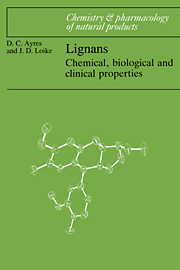Book contents
- Frontmatter
- Contents
- To students and colleagues in Westfield College, 1965–1984.
- Preface
- Glossary for lignans
- 1 Introduction
- 2 A registry of the natural lignans
- 3 Biological and clinical properties of podophyllotoxin and other lignans
- 4 Etoposide and Teniposide
- 5 Isolation, purification and initial characterisation
- 6 Determination of structure
- 7 Biosynthesis
- 8 Synthesis
- Botanical index
- General index
7 - Biosynthesis
Published online by Cambridge University Press: 05 February 2012
- Frontmatter
- Contents
- To students and colleagues in Westfield College, 1965–1984.
- Preface
- Glossary for lignans
- 1 Introduction
- 2 A registry of the natural lignans
- 3 Biological and clinical properties of podophyllotoxin and other lignans
- 4 Etoposide and Teniposide
- 5 Isolation, purification and initial characterisation
- 6 Determination of structure
- 7 Biosynthesis
- 8 Synthesis
- Botanical index
- General index
Summary
The dimeric lignans can be related to lignin, the three-dimensional polymer which is intercalated with cellulose and hemicelluloses so as to rigidify the structure of vascular plants. In the absence of direct evidence of lignan biogenesis it was assumed that dimerisation involved similar precursors and processes to those that had been demonstrated for lignin. Although some direct evidence of the formation of lignans from cinnamyl precursors is now available, much still depends on the lignin analogy. There is also some indication that experiments designed to evaluate pathways in the lignan pool are affected by the co-existence in vivo of a pool of intermediates for lignin synthesis and a brief account of its chemistry is therefore given by way of introduction.
The chemistry of lignin
One-third of the world's land surface is covered by forest containing 3 × 105 million cubic metres of timber and some 2.6 × 109 cubic metres are harvested annually. This amounts to a production of 1.3 × 109 metric tons or twice the world production of steel. Cellulose and hemicelluloses form over half of this but lignin is the remaining bulk constituent and is therefore the second largest natural source of organic material: it is restricted to vascular plants (Fengel and Wegener, 1984).
A diagramatic representation (Pettersen, 1984) of a lignin structure is shown (Scheme 7.1). The structure is constructed by the random linking of the three trans-(E)-monolignols (7.1) through free radicals (7.2A–C) generated by peroxidases bound to the cell wall. (Grisebach, 1981).
- Type
- Chapter
- Information
- LignansChemical, Biological and Clinical Properties, pp. 269 - 302Publisher: Cambridge University PressPrint publication year: 1990
- 1
- Cited by



